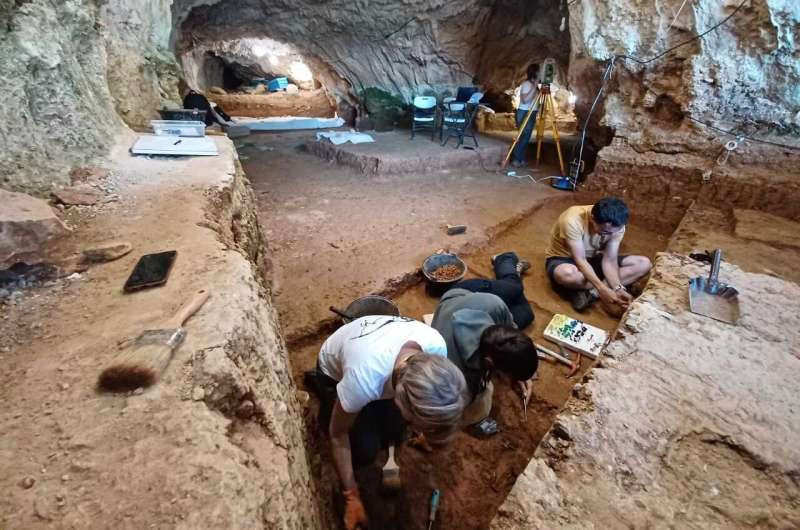This article has been reviewed according to Science X's editorial process and policies. Editors have highlighted the following attributes while ensuring the content's credibility:
fact-checked
proofread
Charcoal, ashes and coprolites: Latest findings shed light on the Neanderthals at Prado Vargas

Geologist Alfonso Benito Calvo, a researcher at the Centro Nacional de Investigación sobre la Evolución Humana (CENIEH), is one of the codirectors of the ninth excavation campaign at the Neanderthal site of Prado Vargas, a cave in the Ojo Guareña karst complex, in the north of the province of Burgos, where more than 2,000 remains of fauna and stone tools were recovered in the month of August.
Specifically, the 30 square meters excavated this year from Level 4 (46,000 years old) yielded teeth and bone fragments from cave bears (Ursus speleaeus), wild boar (Sus scrofa), horses (Equus ferus) and red deer (Cervus elaphus), as well as numerous flint and quartzite tools, among which the highlights are racloirs and rough-edged flakes.
The main novelty of this campaign is the recovery of a hearth, which was raised en bloc for more detailed processing and study in the laboratory. Analysis of the ashes, charcoal and scorched sediments and materials will reveal which species of trees were in the landscape, the temperature the fire reached, its structure, and when the hearth was used.
The second major finding included eight coprolites (fossilized feces) from cave bears, which will offer information about these animals' diet and genetic makeup. Analyzing these will also allow us to see which fruit and plants were among the biotic resources of the zone 46,000 years ago, and which might therefore have been gathered by the Neanderthals who occupied Cueva de Prado Vargas.
Neanderthal occupation
This year's excavation has evinced the existence of different sublevels within Level 4, showing that the cave was occupied by various Neanderthal generations, who used the cavity as their fireplace for hundreds or thousands of years.
"We have collected samples of charcoal and bones from the different sublevels for dating and so that we can see exactly how much time elapsed between the different occupations," write the three codirectors of Prado Vargas, Alfonso Benito Calvo, Marta Navazo Ruiz (Universidad de Burgos) and Rodrigo Alonso Alcalde (Museo de la Evolución Humana and Universidad de Burgos).
Including this ninth campaign, more than 15,000 remains have been recovered which, as the codirectors also explain, make Prado Vargas a key place in our scientific understanding of how the last Neanderthals to occupy this part of the Iberian Peninsula lived.
The most important of these pieces is a deciduous molar from an 8-year-old Neanderthal girl dubbed Vera: To date, this is the most ancient human remains discovered in the Ojo Guareña karst complex.
Scientific outreach
Since this project got under way in 2016, one of its hallmarks has been communicating the progress and results of the excavations to those living nearby. With this in mind, participatory activities were carried out so that local people and visitors to the area could discover what the different excavation campaigns had found.
During this year's campaign, the activities included an open day and a talk given by the codirectors Navazo Ruiz and Benito Calvo in the Casa de Cultura in Villarcayo, organized by the Asociación Cultural Amigos de Villarcayo, with the collaboration of the town's council.
However, the undoubted star among the activities was the workshop where archaeological sediments from the site were washed. Over three days, the children and adults who came washed a half-ton of sediments from its Level 4, recovering more than 50 pieces including small fragments of burned bones, various mole and rodent teeth, and numerous pieces from flint knapping. This was organized in collaboration with Ráspano Ecoturismo and the Ojo Guareña Natural Monument Interpretation Center.
Provided by CENIEH




















